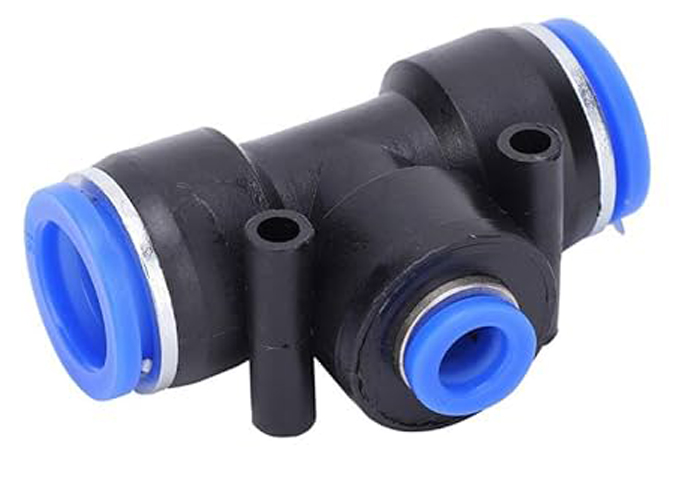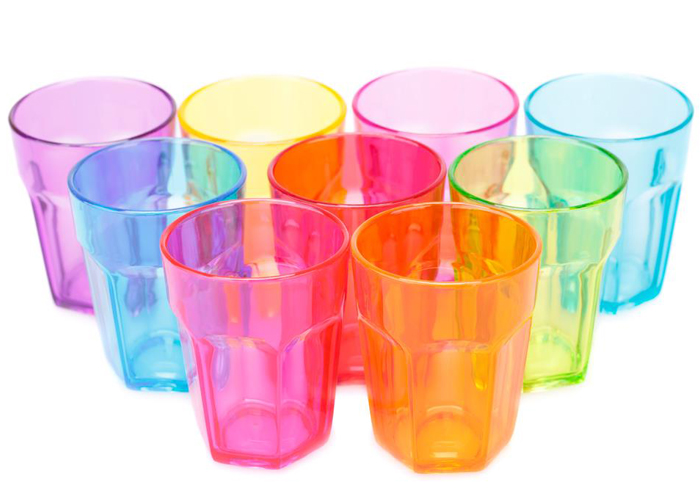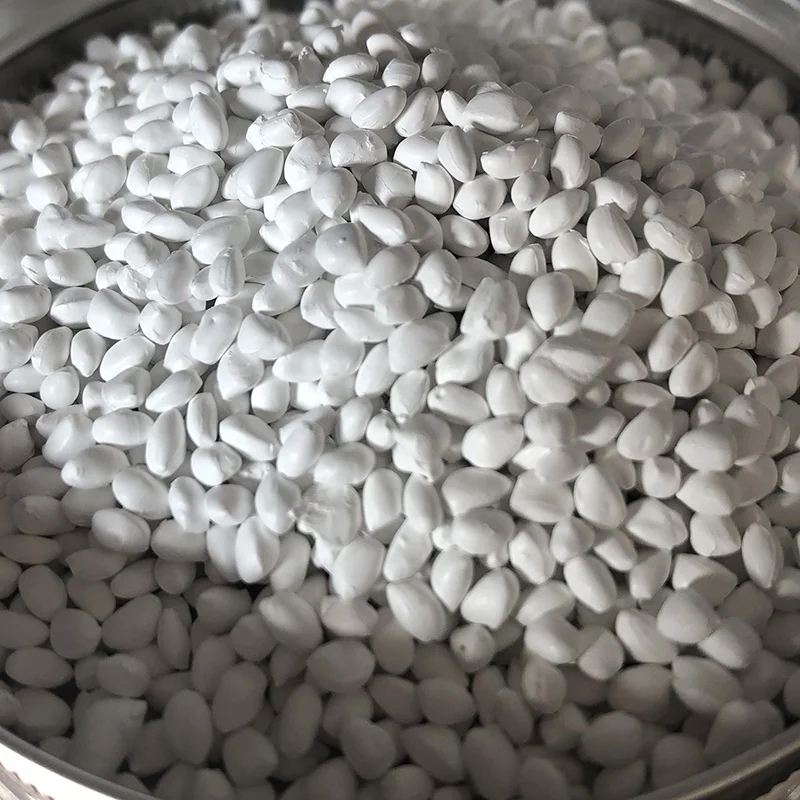
- +8615880211820
- [email protected]
- No.67, Tongan Industry Park, Xiamen
SPECIFICATION DATA SHEET | |||
ITEM | UNIT | VALUES | METHOD |
Color | – | White | – |
Tio2 | % | 80 | – |
Melting point | ℃ | 123-130 | ISO11357-3:1999 |
Melt mass-flow rate/MFR | g/10min | 35±5 | ASTM D-1238 |
heat resistant | ℃ | ≤220 | DIN53772 |
anti-aging | 1-8 grade | ≥5 | ASTM G152-G155 |
moisture content | % | ≤0.15 | ASTM D6980-04 |
long granule | % | ≤0.1 | – |
Application: Moulding injection, Pipes, Tubes, Blowing film, Cast film, etc. | |||
White masterbatch, a concentrated color granule comprising Titanium Dioxide (TiO2), carrier resins, and various additives, plays a pivotal role in transforming the color and properties of end-products. In this article, we explore the exceptional features of high-quality high dispersion TiO2 white masterbatch, specifically tailored for film applications.
White masterbatch primarily contains a substantial concentration (typically 80%) of titanium dioxide, a versatile pigment known for its exceptional dispersion capabilities, heat resistance, and thermal stability. TiO2, renowned for its ability to scatter light effectively, enhances opacity, brightness, and lightness in materials where it is incorporated. Notably, the pigment also demonstrates UV light absorption, significantly improving the durability of end-products, particularly in challenging weather conditions.
The mechanical properties of materials infused with TiO2 white masterbatch are commendable, showcasing robust resistance to impacts and tears. This versatility is further amplified by the diverse range of base resins available, including PP, PE, PS, ABS, and polyester, making it suitable for various molding processes such as blow molding, injection molding, and high-end rotational molding.
Color Enhancement and Opacity: TiO2 provides opacity by reflecting light through refraction and diffraction, resulting in a perfect white color for end-products.
UV Light Protection: The ability of TiO2 to absorb UV light contributes to enhanced durability, especially in outdoor applications subjected to weather conditions.
Heat Resistance: The inclusion of high concentrations of TiO2 improves the heat resistance of materials, ensuring stability under elevated temperatures.
Weather Durability: Products infused with TiO2 white masterbatch exhibit good weather durability, making them suitable for a range of environmental conditions.
Customizable Color Choices: White masterbatch is available in various types, offering a spectrum of color choices tailored to meet specific customer requirements.
In response to evolving market conditions, manufacturers have developed a portfolio of cost-effective white masterbatches. This involves utilizing a wide selection of carrier resins, TiO2 grades, fillers, and extenders. Understanding customer performance requirements, including extrusion processes, FDA compliance, and dispersion needs, guides the formulation of tailored white masterbatch solutions.
Our white masterbatches find application in diverse industries, including textiles, film production, packaging, pipelines, disposable containers, and polymer segmentation. Notably, they are instrumental in the agricultural sector for applications such as silos and inorganic mulches.
The versatility of white masterbatch extends to the production of polymer sections, extrusion and injection parts, and multi-layer pipes with high shock resistance, showcasing its adaptability across various manufacturing processes.
Improved Light Reflectance: TiO2’s reflective properties contribute to the improved light reflectance of materials infused with white masterbatch. This results in a brighter and more visually appealing appearance, making it ideal for applications where aesthetics matter.
Enhanced Whiteness and Brightness: The high concentration of titanium dioxide ensures a superior level of whiteness and brightness in the end-products, making them suitable for applications requiring a pristine and clean visual appeal.
Compatibility with Various Polymers: White masterbatch is formulated to be compatible with a broad spectrum of polymer systems. This versatility allows manufacturers to integrate it seamlessly into different production processes, ensuring uniform color dispersion.
FDA Compliance: Some white masterbatches are designed to meet Food and Drug Administration (FDA) standards, making them safe for use in applications involving food packaging and other consumer products where regulatory compliance is crucial.
Multi-Functional Concentrates: The availability of multi-functional concentrates, containing various percentages of TiO2 (50%, 60%, 70%, and 80%), allows manufacturers to choose formulations that align with specific application requirements. Additive packages, such as hindered amine light stabilizers (HALS) and antistatic agents (A/S), further enhance the performance of these concentrates.
Conclusion: High-quality high dispersion TiO2 white masterbatch stands as a cornerstone in the realm of polymer coloring and enhancement. Its ability to impart a perfect white color, enhance opacity, provide UV protection, and improve mechanical properties makes it an indispensable component in the production of films and a wide array of plastic products. As market demands continue to evolve, the development of tailored solutions ensures that white masterbatch remains a key player in the pursuit of both aesthetic and functional excellence in polymer-based applications.
Our company is over 20 years in plastic masterbatch industry, we specialize in researching and produce all kinds of Color masterbatches, functional masterbatch, fiberglass reinforced plastics and burning resistant plastic raw materials, located in Tong’an Industry Park of Xiamen City in China.
In conclusion, we are professional in producing all kinds of plastic masterbatch, including additive master-batch, functional masterbatch, PE flame retardant masterbatch, ABS flame retardant masterbatch, Anti-Oxygen masterbatch, Anti-UV masterbatch, Anti-bacterial masterbatch, Antiblock masterbatch, and some other additive masterbatches.
Our masterbatches find a multitude of applications across diverse industries. Whether in plastics, textiles, or various manufacturing processes, our masterbatches play a pivotal role in enhancing product quality and performance. With customizable formulations, they offer color consistency, UV protection, flame resistance, and more, making them the go-to solution for countless applications. From automotive parts to packaging materials, our masterbatches are the trusted choice for achieving superior results across a wide spectrum of industries.
Our custom masterbatches are designed to match specific polymers, ensuring optimal performance when incorporated into your selected material. We have the capability to produce masterbatches suitable for a variety of polymers mentioned below, and many more. If you’re working with a material that isn’t listed here, please don’t hesitate to reach out to our knowledgeable technical team to explore the possibility of meeting your specific needs.

Low Density Polyethylene – Somewhat more translucent than HDPE and considerably more pliable, primarily employed in flexible packaging, tote bags, pliable tubing, film applications, and similar uses. Like HDPE, it has limited transparency characteristics. It exhibits outstanding chemical resistance to alcohols, acids, and alkalis but has restricted resistance to hydrocarbon solvents and mineral oils. Prolonged exposure to UV radiation can initiate degradation.
High-Density Polyethylene – Featuring a somewhat milky-white appearance, this material finds wide application in rigid bottle packaging, injection-molded caps and closures, crates, and more. Its natural opacity can limit the degree of transparency attainable. HDPE exhibits superior chemical and solvent resistance when compared to LDPE.


PPCO Random & PPHO – A polymer with moderate clarity, employed in the production of caps and closures. It is also utilized for crafting household items, buckets, toys, and storage containers. Polypropylene offers flexibility without significant limitations on color or special effects. Random copolymer boasts greater clarity compared to homopolymer and is better suited for creating translucent shades.
PPCO Block – Similar to PPCO but enhanced for increased impact resistance. An additive renders the polymer white, resulting in high opacity. This characteristic may limit the achievable transparency.
Polyethylene Terephthalate (PET) – Polyester materials exhibit robust mechanical strength along with excellent chemical resistance and barrier properties. PET is frequently chosen for the production of carbonated beverage containers. Moreover, polyester can be spun and employed in textile manufacturing for clothing. PET is highly transparent, making it an excellent choice for translucent packaging, although a subtle hint of “yellowing” may impact extremely light tints.


Polybutylene Terephthalate – A crystalline thermoplastic engineering polymer frequently employed as an insulating material within the electronics sector. This substance belongs to the polyester category, showcasing a remarkable equilibrium of attributes and processing qualities.
General Purpose Polystyrene – Exhibiting a glass-clear appearance but possessing minimal impact resistance, this material finds its primary application in CD cases. Its notable clarity renders it suitable for creating translucent hues, although an occasional violet tint may be discernible.


High Impact Polystyrene – Derived from GPPS by incorporating an impact-enhancing agent to boost its resistance to impacts. This added component results in the polymer becoming white, and different formulations provide varying degrees of opacity. Typically employed in the fabrication of game pieces, toys, and similar items. Its pronounced whiteness can pose challenges when aiming for translucent coloration. Specialized alternatives like K-Resin and Styrolux are accessible in the market to attain the same level of translucency as GPPS.
Acrylonitrile Butadiene Styrene (ABS) – A more robust iteration of High Impact Polystyrene (HIPS) employed in high-value components. ABS exhibits greater durability compared to HIPS-made components, although it encounters similar challenges when attempting to achieve translucent colorations. Just like HIPS, ABS offers specialized translucent variants. Owing to its durability, ABS is commonly used in crafting casings for power tools.


Polyamide (6, 66) – Nylon represents a versatile grade extensively employed in mechanical construction and maintenance. Its popularity stems from its excellent blend of mechanical strength, rigidity, mechanical damping characteristics, and effective electrical insulation capabilities. Consequently, nylon is a preferred material for manufacturing electrical enclosures. PA66 serves as a common alternative to metal across diverse applications, with its chemical and physical attributes closely resembling those of PA6. PA6 exhibits superior impact resistance and resistance to solvents, albeit with a heightened susceptibility to moisture absorption.
Styrene Acrylonitrile Copolymer – Possessing transparency and outstanding chemical and heat resistance, SAN also boasts good rigidity, tensile strength, and flexural strength. Thanks to its high-gloss finish, SAN is commonly chosen for cosmetic packaging purposes. However, achieving light tint colors with SAN can be challenging due to the violet dyestuffs inherent in the material, which are utilized to enhance its visual appearance during manufacturing.


Polyethylene Terephthalate Glycol – PET with the incorporation of glycol. This glycol addition enhances flow properties but diminishes strength. PETG can be extruded to create bottles and can be formed into sheets for producing ‘blister’ style packaging.
Thermoplastic Elastomer (TPE) or Thermoplastic Polyurethane (TPU) – TPU finds diverse uses in applications such as automotive instrument panels, caster wheels, power tools, medical devices, as well as various extruded film, sheet, and profile applications. TPEs are employed across a wide range of applications in industries spanning automotive, medical, construction, electrical, appliances, packaging, and industrial sectors.

Frequently asked questions about our masterbatch





©2023. Masterbatch Manufacturer All Rights Reserved.
Our team will send back the best offer in 20 minutes.